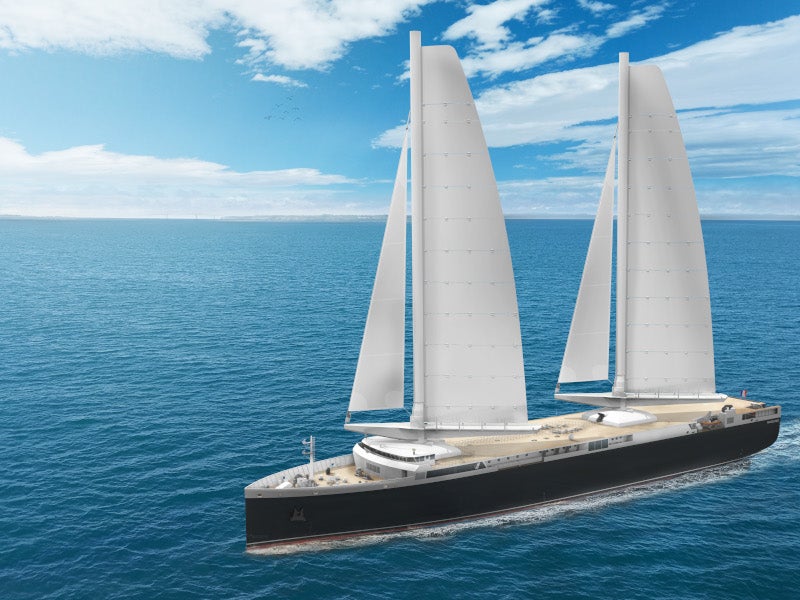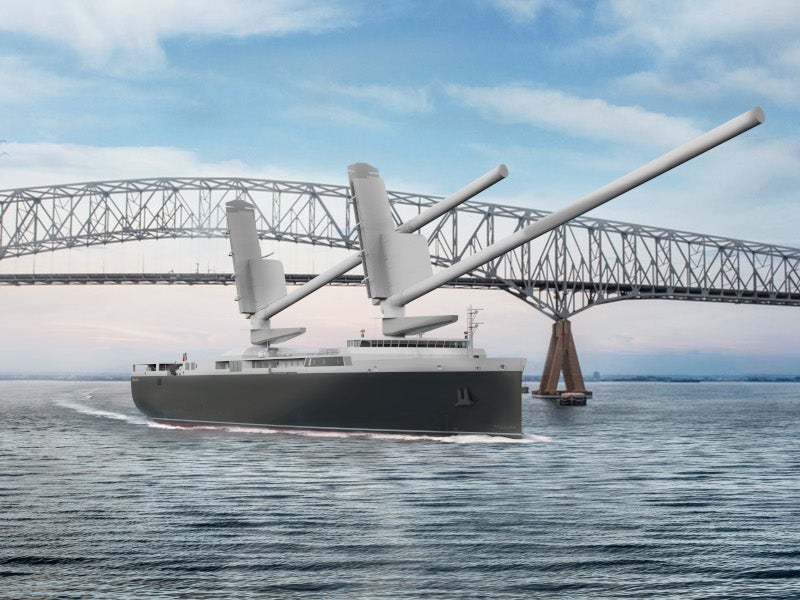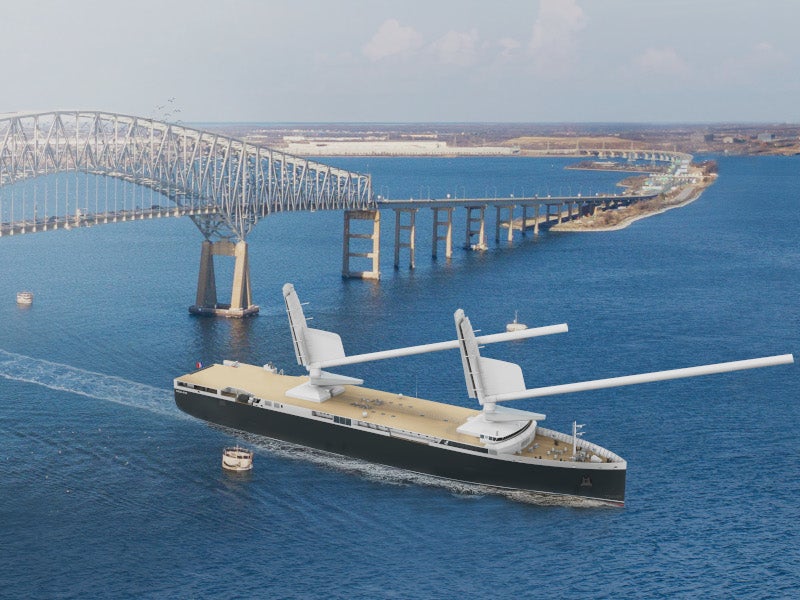The NEOLINER ORIGIN is a sailing roll-on/roll-off (Ro-Ro) cargo vessel being constructed by RMK MARINE for NEOLINE, a maritime company based in France, to transport transoceanic freight.
NEOLINE launched the construction of the first vessel in January 2023. The construction commenced with the steel-cutting ceremony in November 2023.
Expected to enter service in June 2025, the vessel will operate on a transatlantic route connecting the ports of Saint-Nazaire, Saint-Pierre-et-Miquelon, Baltimore, and Halifax.
NEOLINER ORIGIN Ro-Ro vessel design and features
The 136m-long vessel measures 24.2m wide and has a variable draft of 5.5m in port and 14m offshore. The vessel’s air draft varies between 88.2m with masts upright and 42m when tilted. The vessel displaces 11,000t of water and has a deadweight capacity of 5,000t.
Its main deck covers an area of 2,236m² (24,068ft²) and measures 121m long, 21.2m wide and a maximum height of 9.8m. The garage has an area of 1,200m², measuring 81.6m long, 14.6m wide, and 5.3m high.
It has the flexibility to accommodate up to 12 passengers in six double cabins during its different rotations. Additionally, it can accommodate 13 crew members, which can extend up to 20.
It also features a battery room for zero-emission electric navigation, a rescue boat with a launch and recovery davit, and a Yokohama fender.
Propulsion system of the NEOLINER ORIGIN
NEOLINER ORIGIN’s rigging system features two Solid Sail folding carbon masts standing 76m high to offer eco-friendly transportation. The sail technology comprises a main sail with an area of 1,100m² and a flexible jib covering 400m², resulting in a total sail area of 3,000m². The sailing propulsion system is designed to retract, allowing the vessel to access most ports.
The vessel will be the first one to be equipped with a Solid Sail rigging system.
The propulsion system combines the sails with a hybrid diesel-electric power system with a 4,000kW output. The main thrusters include a controllable pitch propeller (CPP) and a rudder while auxiliary thrusters include two bow thrusters and an aft tunnel thruster, each delivering 450kW.
The main engine produces a total of 3,184kW, with an additional 900kW from electric sources. The electrical system comprises two generators, each producing 665kVA.
Additionally, the vessel will be outfitted with an auxiliary engine and desulphurised generators using marine gasoil (MGO), to ensure smooth port manoeuvres and maintain service punctuality. Each exhaust will be equipped with selective catalytic reduction (SCR) to suppress NOₓ emissions. Also, it will be equipped with three transverse thrusters.
The vessel will operate at a commercial speed of 11kt and can reach a maximum speed of 14 knots under sail, aided by onboard weather routing equipment. Its cruising speed under engine power is 12.9 knots while the range is 7,000 nautical miles (nm).
Cargo capacity of the NEOLINER
The NEOLINER has a loading capacity of 1,200 linear metres (2.8m wide) or 265 twenty-foot equivalent units (TEUs), with a maximum cargo weight of 5,300t, making it suitable for various cargo types such as rolling stock, outsized items, and general cargo.
Equipped with a loading ramp, the vessel has three protected loading zones – a 1,150m² main garage, a 368m² steerage area, and an 850m² lower garage, completely protected and secured from harsh weather conditions. It can load light and oversized items up to 9.8m high, 12.60m wide, and 200t without lifting.
In terms of volume, the NEOLINER can transport 1,500 linear metres of Ro-Ro cargo or 500 cars, 265 TEUs of containers, and up to 5,000t of conventional cargo.
Financing details
The project’s budget exceeds €60m ($64.8m). The equity portion of the funding was contributed by CMA CGM Group, ADEME Investissement, NEOLINE Développement, Corsica Ferries, and Louis Hardy.
The Banque des Territoires has provided bond financing of €3.8m ($4.1m) while the Pays de la Loire Region has offered a reimbursable advance of €1.3m ($1.4m).
The Crédit Industriel et Commercial (CIC) is supplying bank financing through a tax lease, backed by a Strategic Projects Guarantee from Bpifrance Assurance Export.
EDF has also joined the project, with a 2019 agreement to issue Energy Savings Certificates (CEE), marking a first for the shipping sector.
Additionally, NEOLINE has secured investment from various sources, including the community of investors in participatory financing WiSEED, the company ARCAD, and funds from Mer Invest and Pays de la Loire Participations, to fund its project.
Sustainability features
NEOLINE has been developing the vessel since 2016 to create a low-carbon, economically stable maritime transport option that is less dependent on fluctuating oil prices.
The vessel aims to reduce greenhouse gas emissions by 80% to 90% compared to conventional diesel-powered cargo vessels on the same transatlantic route.
The NEOLINER’s design is protected by an international patent and is expected to save 600,000MWh cumac over 15 years.
Contractors involved
Chantiers de l’Atlantique is responsible for providing the ship’s rigging system and sails.
D-ICE Engineering, a deep-tech company, is set to provide modern systems for routing, navigation, piloting, and monitoring, all of which are tailored to the vessel’s wind propulsion technology.
Fouré Lagadec, a pressure equipment supplier, is offering services to design and manufacture anti-drift fins that are both foldable and orientable.
Mauric, a naval architecture and marine engineering company, is tasked with conducting design studies, as well as regulatory and performance analyses, for NEOLINE’s fleet of ships, ensuring that the vessels meet all necessary standards and perform optimally.
Engie Axima, a heating, ventilation and air-conditioning (HVAC) and refrigeration company; and Bio-sea UV, a water treatment solutions provider, are also involved in the development process.










